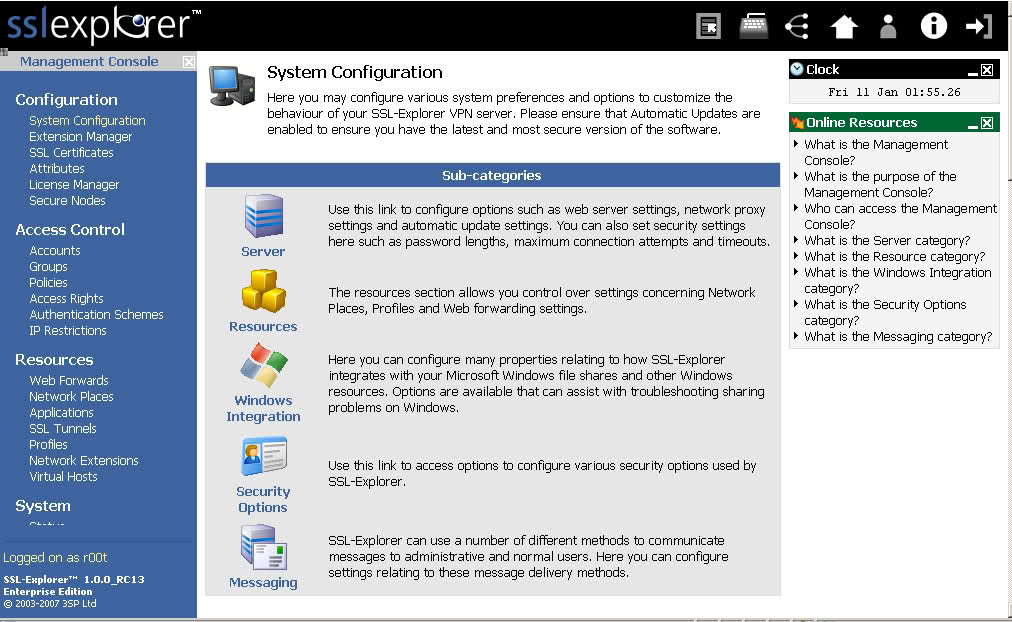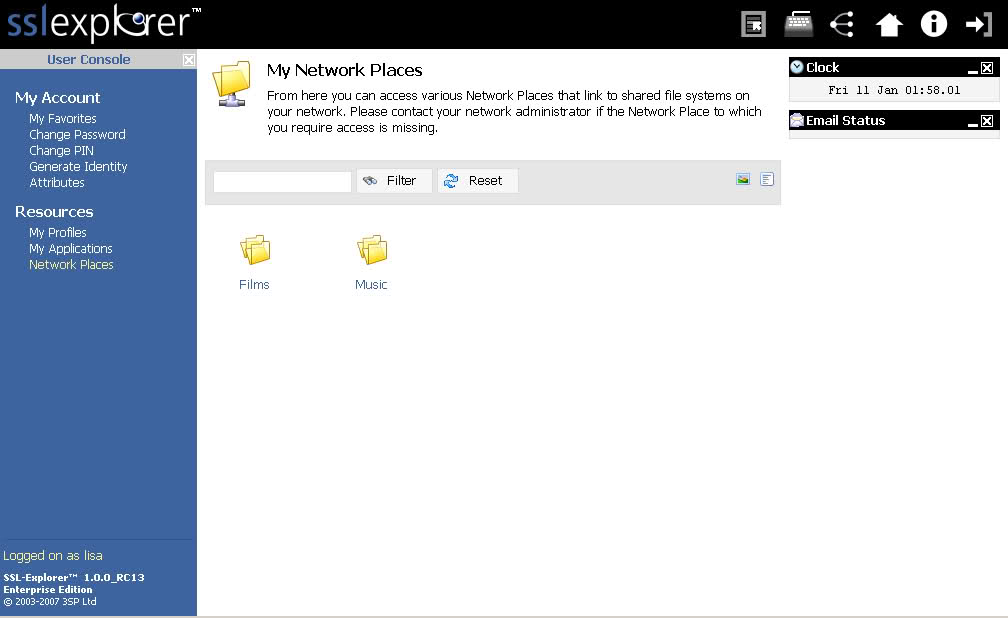SSL Explorer
I wanted to become the owner of the sea ... well, that is, so that I could manage my home network, being anywhere (equipped with Internet access, of course). Remotely managing a single computer is easy — remote administration solutions abound ...
But I have three computers at home, and I want at any time to have access to information on each of them without the hassle and worries.
So - VPN.
It is desirable without client applications and that from under any system it is not enough where it is difficult to carry it.
It means that the well-known solutions are swept aside with the client part.
It is desirable - through the common ports (others can be closed by the administrator of the place where hard is brought), well, encryption will not interfere.
So - ...
Having rummaged in the internet for solutions of this kind, I discovered a subject for myself.
So, SSL-Explorer . A powerful VPN server, developed by 3SP Ltd , distributed under a GNU license, based on Java, working under an SSL protocol, controlled via a web interface, Nordic character ... oops ... :) In general, I thought, here's a little thing that is perfect for my needs! It turned out - even too much; there are many such functions in it that I probably will not need ... but others may come in handy.
Here is part of what he can and has:
Server versions for operating systems Microsoft Windows XP / 2000/2003 / Vista , Apple Mac OS X Tiger or later, Linux
Supported by all modern browsers: Internet Explorer 5 , IE6 , IE7 , Mozilla Firefox , Opera , Safari and others
Flexible rights management based on access policies
Reverse proxy for web forwarding
Active Directory authentication, UNIX authentication and authentication through its own built-in user base are supported.
Configurable authentication schemes
Remote Desktop Access in Various Ways
Intranet resources can be safely shared using web forwarding.
Supports access via HTTP or SOCKS proxy
Local and remote tunneling over SSL
Timeouts during session inactivity
Connection of many users simultaneously
')
A full list of features is available here .
It should be noted that SSL-Explorer is not intended for organizing a single virtual network through a VPN tunnel, like OpenVPN (based on IPSec ), which is more appropriate for establishing a permanent tunnel and, thus, is used for other tasks. This is just an excellent tool for remotely managing network resources from any convenient place, and it performs its duties brilliantly (by the way, for those who need it for these purposes, I advise you to specify when installing your own database of users, and not to use OS authentication policies ).
Of all the features of the program, I was interested in the flexible management of user rights (I also want friends to open something in their own grid, each with their own), remote desktop access to any of the grid’s computers, a convenient balloon of folders on any computer on the network (resources can be add to favorites and have quick access to them). You can configure email and SMS notifications on the server. And the interface of the control panel, which opened to me after installing the program, simply enchanted me. Solid Web 2.0, everything is well thought out, the menu is intuitive, all blocks are context-sensitive and as informative as possible, I can’t see enough =) I noticed one minus (which is not a minus for me personally): although formally there is a “Russian” item in my choice of languages, but I did not notice any differences from the English interface with this choice. Nothing, we are not proud people, and so come down)
A couple of screenshots to present what is being said.
So, here's a view of the server from the admin control panel:

But what a connected user sees:

Installing the server is intuitive, so I’m not going to paint step by step, tea, smart people gathered =)
After installation, you need to go under the root created during the installation process to the control panel at the local address localhost : 443 and create different policies for the groups that you intend to use: for example, for yourself, your beloved, for friends, for guests (do not forget to deactivate the root for security) ... In each policy, you can determine what the groups and individual users belonging to it will be capable of. In particular - and this is one of the most important points - you can (and should) create shortcuts for programs that can be used by relevant users. And there are sooo many possible SSL-Explorer programs that are called extensions that it manages with xml-configs. Instead of developing their own tools for managing remote computers, the creators of SSL-Explorer gave the user a choice of the most familiar and convenient way, such as: PuTTy , Linux RDesktop , Windows RDP , UltraVNC , Radmin and many, many others. Of course, after making a choice, the program will have to be pre-configured.
If you wish, you can build the complex yourself from source, as well as embed your own extensions there: instructions on the example of screwing the popular TightVNC . By the way, it seems that in the latest version of the TightVNC server you no longer need to add it yourself - it is present in the list of available programs!
After connecting to the server from the place where hard it has brought, you just have to click on the label of your favorite tool and get access to any of the computers in your local computer. And if you don’t plan to provide such wide access to other users, they may be limited to folders of movies and music on your network.
In general, try it, feel it - perhaps SSL-Explorer will bring you no less pleasure and benefit than I do) The program is worth mentioning unequivocally.
But I have three computers at home, and I want at any time to have access to information on each of them without the hassle and worries.
So - VPN.
It is desirable without client applications and that from under any system it is not enough where it is difficult to carry it.
It means that the well-known solutions are swept aside with the client part.
It is desirable - through the common ports (others can be closed by the administrator of the place where hard is brought), well, encryption will not interfere.
So - ...
Having rummaged in the internet for solutions of this kind, I discovered a subject for myself.
So, SSL-Explorer . A powerful VPN server, developed by 3SP Ltd , distributed under a GNU license, based on Java, working under an SSL protocol, controlled via a web interface, Nordic character ... oops ... :) In general, I thought, here's a little thing that is perfect for my needs! It turned out - even too much; there are many such functions in it that I probably will not need ... but others may come in handy.
Here is part of what he can and has:
Server versions for operating systems Microsoft Windows XP / 2000/2003 / Vista , Apple Mac OS X Tiger or later, Linux
Supported by all modern browsers: Internet Explorer 5 , IE6 , IE7 , Mozilla Firefox , Opera , Safari and others
Flexible rights management based on access policies
Reverse proxy for web forwarding
Active Directory authentication, UNIX authentication and authentication through its own built-in user base are supported.
Configurable authentication schemes
Remote Desktop Access in Various Ways
Intranet resources can be safely shared using web forwarding.
Supports access via HTTP or SOCKS proxy
Local and remote tunneling over SSL
Timeouts during session inactivity
Connection of many users simultaneously
')
A full list of features is available here .
It should be noted that SSL-Explorer is not intended for organizing a single virtual network through a VPN tunnel, like OpenVPN (based on IPSec ), which is more appropriate for establishing a permanent tunnel and, thus, is used for other tasks. This is just an excellent tool for remotely managing network resources from any convenient place, and it performs its duties brilliantly (by the way, for those who need it for these purposes, I advise you to specify when installing your own database of users, and not to use OS authentication policies ).
Of all the features of the program, I was interested in the flexible management of user rights (I also want friends to open something in their own grid, each with their own), remote desktop access to any of the grid’s computers, a convenient balloon of folders on any computer on the network (resources can be add to favorites and have quick access to them). You can configure email and SMS notifications on the server. And the interface of the control panel, which opened to me after installing the program, simply enchanted me. Solid Web 2.0, everything is well thought out, the menu is intuitive, all blocks are context-sensitive and as informative as possible, I can’t see enough =) I noticed one minus (which is not a minus for me personally): although formally there is a “Russian” item in my choice of languages, but I did not notice any differences from the English interface with this choice. Nothing, we are not proud people, and so come down)
A couple of screenshots to present what is being said.
So, here's a view of the server from the admin control panel:

But what a connected user sees:

Installing the server is intuitive, so I’m not going to paint step by step, tea, smart people gathered =)
After installation, you need to go under the root created during the installation process to the control panel at the local address localhost : 443 and create different policies for the groups that you intend to use: for example, for yourself, your beloved, for friends, for guests (do not forget to deactivate the root for security) ... In each policy, you can determine what the groups and individual users belonging to it will be capable of. In particular - and this is one of the most important points - you can (and should) create shortcuts for programs that can be used by relevant users. And there are sooo many possible SSL-Explorer programs that are called extensions that it manages with xml-configs. Instead of developing their own tools for managing remote computers, the creators of SSL-Explorer gave the user a choice of the most familiar and convenient way, such as: PuTTy , Linux RDesktop , Windows RDP , UltraVNC , Radmin and many, many others. Of course, after making a choice, the program will have to be pre-configured.
If you wish, you can build the complex yourself from source, as well as embed your own extensions there: instructions on the example of screwing the popular TightVNC . By the way, it seems that in the latest version of the TightVNC server you no longer need to add it yourself - it is present in the list of available programs!
After connecting to the server from the place where hard it has brought, you just have to click on the label of your favorite tool and get access to any of the computers in your local computer. And if you don’t plan to provide such wide access to other users, they may be limited to folders of movies and music on your network.
In general, try it, feel it - perhaps SSL-Explorer will bring you no less pleasure and benefit than I do) The program is worth mentioning unequivocally.
Source: https://habr.com/ru/post/18552/
All Articles